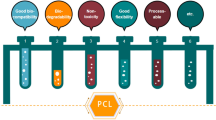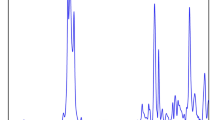Abstract
Supercritical foaming technology is used for producing foamed silicone rubber (SR) materials because of its many advantages, but this technology has been limited by its propensity to prepare microcellular silicone rubber foams (SRF) with surface defects. In this study, a novel method of preparing microcellular SRF without surface defects was successfully developed by investigating the principle of cellular formation during the process of supercritical foaming. Meanwhile, the microstructure, surface profile, mechanical properties, and thermal conductivity of microcellular SRF were investigated in detail. The results show that the plasticity of the SR matrix plays an important role in cellular formation. The maximum tensile strength of the microcellular SRF achieves 4.77 MPa and the elongation at break is 1866.29%. The thermal conductivity of the microcellular SRF achieves a minimum value of 0.14 W/m K, and the thermal insulation property is improved by approximately 39% compared with the SR composites.
This is a preview of subscription content, access via your institution
Access options
Subscribe to this journal
Receive 12 print issues and online access
$259.00 per year
only $21.58 per issue
Buy this article
- Purchase on Springer Link
- Instant access to full article PDF
Prices may be subject to local taxes which are calculated during checkout









Similar content being viewed by others
References
Zhou NL. Introduction of silicone polymer. Beijing: Science Press; 2000.
Hu SS. Cushioning and damping of vibration of low density porous material. J Vib Shock. 1999;18:18–43.
Wang YB. Research on silicone rubber damping material. Mater Rev. 2004;18:50–3.
Liu PB, Liu DL, Zou HW, Fan P, Xu W. Structure and properties of closed-cell foam prepared from irradiation crosslinked silicone rubber. J Appl Polym Sci. 2009;113:3590–5.
Zhao XW, Zang CG, Sun YL, Zhang YL, Wen YQ, Jiao QJ. Effect of hybrid hollow microspheres on thermal insulation performance and mechanical properties of silicone rubber composites. J Appl Polym Sci. 2017;135:46025.
Jeddi J, Katbab AA. The electrical conductivity and EMI shielding properties of polyurethane foam/silicone rubber/carbon black/nanographite hybrid composites. Polym Composite. 2017;39:1–9.
Rhodes JL, Yacoe MD. Preoperative planning for the separation of omphalopagus conjoined twins-the role of a multicomponent medical model. J Craniofac Surg. 2013;24:175–7.
Luo SK, Ding GF, Dai B, Yang M, Liu F. Study on the cell structure and mechanical properties of methyl vinyl silicone rubber foam materials. Adv Mater Res. 2014;1004–1005:297–306.
Hong I-K, Lee S. Microcellular foaming of silicone rubber with supercritical carbon dioxide. Korean J Chem Eng. 2013;31:166–71.
Song LX, Lu A, Feng PJ, Lu ZY. Preparation of silicone rubber foam using supercritical carbon dioxide. Mater Lett. 2014;121:126–8.
Liao X, Xu H, Li SJ, Zhou CJ, Li GX, Park CB. The effects of viscoelastic properties on the cellular morphology of silicone rubber foams generated by supercritical carbon dioxide. RSC Adv. 2015;129:106981–8.
Yang Q, Yu HT, Song LX, Zhang F, Lu A, Liu T, et al. Solid-state microcellular high temperature vulcanized (HTV) silicone rubber foam with carbon dioxide. J Appl Polym Sci. 2016;44807:1–9.
Yan H, Wang K, Zhao Y. Fabrication of silicone rubber foam with tailored porous structures by supercritical CO2. Macromol Mater Eng. 2017;302:1600377.
Bai JW, Liao X, Huang EB, Luo Y, Yang Q, Li GX. Control of the cell structure of microcellular silicone rubber/nanographite foam for enhanced mechanical performance. Mater Des. 2017;133:288–98.
Tang WY, Bai JW, Liao X, Xiao W, Luo Y, Yang Q, et al. Carbon nanotube-reinforced silicone rubber nanocomposites and the foaming behavior in supercritical carbon dioxide. J Supercrit Fluid. 2018;141:78–87.
Bai JW, Liao X, Li GX. Preparation and properties of UV and infrared excitable dual wavelength fluorescent anti-counterfeiting fibers. Polym Eng Sci. 2017;33:155–66.
Li G, Xin S, Xu XJ, Ma FG. Influence of hydroxyl terminated silicone oil on foam peroxide curing system of silicone foam. J Funct Mater. 2016;5:375–9.
Feng PJ, Song LX, Lu ZY, Lu A. Study on high temperature vulcanizing silicone rubber foamed by supercritical carbon dioxide. J Mater Eng. 2011;8:62–7.
Xiang B, Deng ZP, Zhang FS, Liu T, Luo S K. Microcellular silicone rubber foams: the influence of reinforcing agent on cellular morphology and nucleation. Polym Eng Sci. 2018;59:1–10.
Liu T, Lei YJ, Zhang FS, Guo SY, Luo SK. Microcellular crosslinked silicone rubber foams: influence of nucleation agent (polyhedral oligomeric silsesquioxane) on the rheological, vulcanizing, cell morphological properties. Polym Plast Technol. 2017;12:1623–33.
Satish KG, Eric JB. Effect of pressure and temperature on nucleation. Beijing: Society of plastics engineers Inc.; 1994. p. 34.
Matuana LM, Diaz CA. Study of cell nucleation in microcellular poly(lactic acid) foamed with supercritical CO2 through a continuous-extrusion process. Ind Eng Chem Res. 2010;49:2186–93.
Hu WJ, Chen H, Zhang K. Effect of porosity on properties of open-cell silicone rubber foam. Vol. 45. Beijing: Rubber Industry; 1998. p. 45.
Jose AR, Viot P, Dumon M. Microcellular foaming of polymrthylmethacrylate in a batch supercritical CO2 process: effect of microstructure on compression behavior. J Appl Polym Sci. 2010;118:320–31.
Matsuura K, Saito H. Tensile properties and interfacial adhesion of silicone rubber/polyethylene blends by reactive blending. J Appl Polym Sci. 2017;17:46192.
Ziraki S, Zebarjadn SM, Hadianfard MJ. A study on the tensile properties of silicone rubber/polypropylene fibers/silica hybrid nanocomposites. Sci Direct. 2016;57:289–96.
Li ZH, Lu ZY, Song LX. Preparation and properties of microcellular silicone rubber with supercritical carbon dioxide. J Southwest Univ Sci Technol. 2017;32:1–7.
Ma JZ, Bian CL, Xue CH, Deng FQ. Wear-resistant EPDM/silicone rubber foam materials. J Porous Mater. 2016;23:201–9.
Zhang CL, Zhang CY, Huang R, Gu XY. Effects of hollow microspheres on the thermal insulation of polysiloxane foam. J Appl Polym Sci. 2016;44778:1–7.
Wang GL, Zhao JC, Wang GZ, Lun HM, Parkb CB, Zhao GQ. Low-density and structure-tunable microcellular PMMA foams with improved thermal-insulation and compressive mechanical properties. Eur Polym J. 2017;95:382–93.
Acknowledgements
This work was supported by the National Natural Science Foundation of China (Grant numbers: 51773186 and 51503189).
Author information
Authors and Affiliations
Corresponding authors
Ethics declarations
Conflict of interest
The authors declare that they have no conflict of interest.
Additional information
Publisher’s note Springer Nature remains neutral with regard to jurisdictional claims in published maps and institutional affiliations.
Rights and permissions
About this article
Cite this article
Jia, Y., Xiang, B., Zhang, W. et al. Microstructure and properties of microcellular silicone rubber foams with improved surface quality. Polym J 52, 207–216 (2020). https://doi.org/10.1038/s41428-019-0249-5
Received:
Revised:
Accepted:
Published:
Issue Date:
DOI: https://doi.org/10.1038/s41428-019-0249-5
This article is cited by
-
Design of lightweight silicone rubber foam for outstanding deformation recoverability based on supercritical CO2 foaming technology
Journal of Materials Science (2022)
-
Preparation and properties of silicone rubber materials with foam/solid alternating multilayered structures
Polymer Journal (2021)



